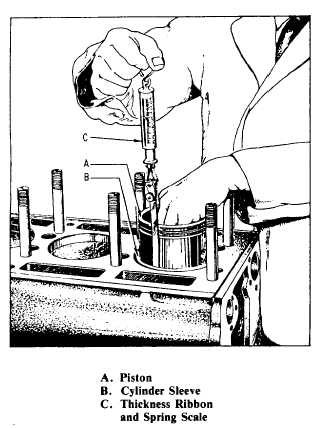(See fig. 3-35.) Measure the fit at the point of greatest piston size. Check the amount of force required to pull out the feeler stock on the spring gauge. If the feeler stock pulls out too easily, the fit is too loose. If it pulls out too hard, the fit is too tight. Check the manufacturer's maintenance manual for the correct amount of clearance.
PISTON PINS FITTING
If the piston-pin bushings are worn, they should be reamed or honed oversize and oversize pins installed. The pins should also be replaced if they are worn, pitted, or otherwise defective.
Where the pin is of the type that floats or turns in the piston-pin bushing, the fit is correct if the pin will pass through with a light thumb pressure when the piston and the pin are at room temperature. Where the pin is of the type that does NOT turn in the piston-pin bushing, the pin is forced in place under pressure. Check the manufacturer's maintenance manual for the correct pressure. If the pressure is too low, the fit is too loose and will result in noise. Excessive pressure indicates that the fit is too tight and may fracture the piston-pin bosses.

Figure 3-35. - Checking piston fit in sleeve.
PISTON RINGS FITTING
Piston rings must be fitted to their cylinder and to their grooves on the piston. First, check the gap or space between the ends of each ring. To do so, push a ring down into the cylinder with a piston, and measure the ring gap with a feeler gauge (fig. 3-36). If the ring gap is too small, try a slightly smaller ring, which will have a larger gap. If the cylinder is worn tapered, the diameter at the lower limit of ring travel (in the assembled engine) will be smaller than the diameter at the top. In this type of cylinder, the ring must be fitted to the diameter at the lower limit of ring travel. If the piston ring is fitted to the upper part of the cylinder, the ring gap will NOT be great enough as the ring is moved down to its lower limit of travel. This means that ring ends will come together and the ring will be broken or the cylinder walls scuffed. In tapered cylinders, make sure that the ring fits the cylinder at the point of minimum diameter or at the lower limit of ring travel.
After the ring gap has been corrected, install the ring in the proper ring groove on the piston and roll it around in the ring groove to be sure that the ring has a free fit around the entire circumference of the piston. An excessively tight fit means the ring groove is dirty and should be cleaned. After the rings are installed in the ring groove, test each ring for clearance by inserting

Figure 3-36. - Measuring ring gap clearance in cylinder bore.
Continue Reading